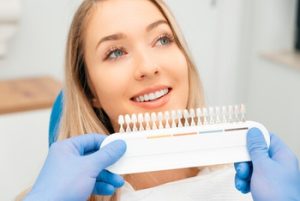Teeth whitening has become one of the most requested cosmetic dental treatments today. Among the various methods available, hydrogen peroxide teeth whitening stands out for its ability to produce visible results. It is widely used in both professional settings and at-home kits, offering flexibility for different preferences and lifestyles. However, the effectiveness and safety of this approach depend on several factors, including concentration levels and proper usage. Understanding how hydrogen peroxide works and how to use it correctly is essential for achieving a brighter smile safely. This guide will walk you through how this whitening method works and whether it’s a worthwhile option for your needs.
How does Hydrogen Peroxide whiten teeth?
Penetrating the Tooth’s Outer Surface
Hydrogen peroxide works by reaching the outer layer of the tooth and penetrating into the enamel. Once inside, it targets compounds that cause discolouration and breaks them down at a molecular level. This reaction helps whiten teeth from within rather than just addressing surface marks. The whitening process is designed to preserve the integrity of the tooth enamel while lifting deep-set stains. Over time, this leads to a cleaner, brighter appearance that looks more natural than surface bleaching.
 Oxidation of Stain Molecules
Oxidation of Stain Molecules
The whitening action comes from an oxidation process that alters the chemical bonds in stain particles. As the hydrogen peroxide breaks down, it releases oxygen molecules that react with the discoloured particles. This reaction causes the bonds within the stains to weaken and break apart. As a result, the tooth becomes lighter in colour without altering its structure. The speed of this process can vary depending on how concentrated the peroxide treatment is.
The Role of Carbamide Peroxide
Carbamide peroxide is another compound frequently found in whitening treatments and is closely related to hydrogen peroxide. When applied, it decomposes into urea and hydrogen peroxide, making it a slower but steady whitening option. This compound is often included in whitening trays for at-home use due to its stability and reduced risk of irritation. It is especially useful for individuals who experience sensitivity during treatment. Dental professionals may recommend it based on your whitening goals and tolerance levels.
Different Forms of Application
There are various ways to apply hydrogen peroxide teeth whitening, including professional treatments and over-the-counter whitening products. In a dental clinic, patients may undergo in chair laser whitening that uses a high concentration of whitening gel activated by a LED light. At home, people use custom made tray kits or whitening toothpaste with lower levels of peroxide. Each approach has its strengths and is suitable for different whitening needs. The choice often depends on how quickly you want results and your comfort level with the procedure.
How Concentration Affects Results
The strength of the hydrogen peroxide used in the whitening solution plays a critical role in the outcome. High-concentration formulas used in professional settings can provide more noticeable outcomes in a shorter timeframe. However, they are usually applied under supervision to ensure they remain enamel safe and to limit the risk of gum irritation. In contrast, lower-strength formulas found in whitening products for at-home use require more applications but can be more comfortable for sensitive users. Your dentist can guide you in opting for the right level for your treatment plan.
Is Hydrogen Peroxide Whitening Safe and Worth It?
Understanding Potential Side Effects
While peroxide teeth whitening is generally safe when applied correctly, some people may experience side effects. The most common issue is tooth sensitivity, which often occurs during or shortly after treatment. This can result from the peroxide penetrating too deeply or irritating the nerves. Gum irritation may also develop if excess gel spills over onto soft tissue. Being aware of these side effects allows for proper precautions and improved comfort throughout the whitening process.
Importance of Supervised Treatment
Having the guidance of qualified dental practitioners makes a considerable difference in both the safety and effectiveness of the treatment. Supervised sessions in a dental chair allow for customised care based on your oral health and whitening goals. Professionals apply the whitening gel accurately and protect the gums with barriers, reducing the chance of side effects. They also monitor your progress to make sure the enamel remains intact, and the results align with expectations. Without this oversight, patients risk using the wrong product or ignoring early signs of complications.
Longevity and Maintenance of Results
The durability of your whitening results relies on the method employed and how well you maintain your oral hygiene afterwards. Brushing with a gentle toothpaste and avoiding foods that cause stains can help extend the life of the whitening. Using whitening toothpaste occasionally can provide a boost without overexposing teeth to active chemicals. Regular check-ups with your dentist ensure that your enamel stays strong and that your whitening results remain consistent. Ongoing care is a key factor in making the treatment a worthwhile investment.
Comparison to Alternative Methods
When comparing peroxide treatment to other whitening options, it is important to look at both results and safety. Natural remedies or non-peroxide based teeth whitening products may be gentler but are typically less effective. Whitening strips and trays with low peroxide concentrations offer convenience but may not be ideal for deep stains. On the other hand, professional hydrogen peroxide treatments provide a balance between efficiency and long-term protection. The right choice depends on your individual needs, lifestyle, and budget.
At-Home vs In-Clinic Whitening
One of the biggest considerations is whether to undergo treatment at a dental clinic or in your own home. While both options can deliver whiter teeth, the in-clinic version is more controlled and often faster. Using whitening trays at home may take longer to achieve the desired shade, but they offer flexibility and can be more affordable. Dental professionals often combine both approaches for a tailored plan. Whichever method you choose, following the correct instructions is essential for safe and effective outcomes.
Contact Our Clinic for Safe, Visible Whitening Results

Final thoughts often come down to one thing; getting noticeable results without compromising the health of your mouth or enamel. With the right approach, hydrogen peroxide can safely deliver brighter teeth and lasting improvements to your smile. To learn more or book a teeth whitening treatment with one of our dentists, call our clinic today and take the first step towards a dazzling smile.
Illawong: (02) 9158 6756
Sylvania Waters: (02) 9159 6083
Pyrmont: (02) 9158 6213
References
https://www.colgate.com.au/oral-health/teeth-whitening/hydrogen-peroxide-for-teeth-whitening
https://pubmed.ncbi.nlm.nih.gov/16607324/


 Oxidation of Stain Molecules
Oxidation of Stain Molecules
